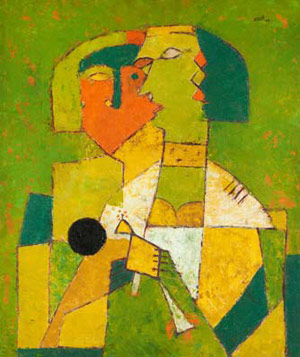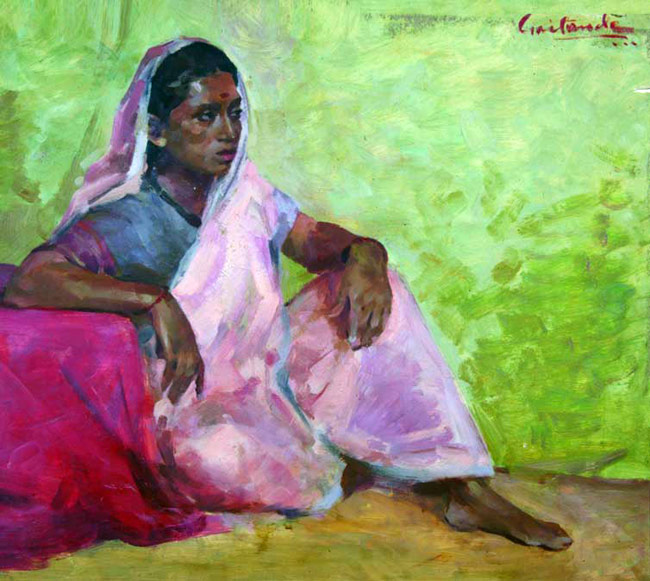Vasudev S. Gaitonde
This is a collection of articles archived for the excellence of their content. |
Book- “Gaitonde”: edited by Satish Naik
Gaitonde at the Guggenheim
Gayatri Jayaraman
June 20, 2014
VS Gaitonde: India's non-objective modernist artist
Chinha's book GaitondeIt's taken three years, an eight-member team and a cross-continental manhunt, from Japan to California the long way around, to put together the most complete collection of Indian non-objective modern and progressive artist V.S. Gaitonde in existence. Sandhini Poddar, adjunct curator at the Solomon R. Guggenheim Museum in New York, says when she began, she didn't even believe she would find any works, let alone receive them on loan from private collections and public institutions. Poddar is still in the process of putting together the first and only solo exhibition of the master held anywhere in the world to date. 'Painting as Process, Painting as Life' opened on October 24, 2014.
It has not been easy for several reasons: While Gaitonde did only four to five paintings a year, he sold them all at once directly to buyers. He did not leave behind an estate when he died in 2001, or indeed any family to catalogue his work, and never archived his work himself. After Pundole Art Gallery founder Kali Pundole, no one, and no gallery, specifically represented him. He was also a Zen master, and a believer in silence. He only allowed the shooting of The Painting As Meditation, a 27-minute film on him directed by Sunil Kaldate, on condition that nobody spoke in it. He gave few interviews, and recorded no in-depth conversations on his process. When he died at 77, there were no biographies on him. There was not even a chronology in place to follow. The effort to put together the idea of Gaitonde has been gruelling. From Mumbai, Poddar undertook the one-hour trip to Kasheli village near Bhiwandi, where Satish Naik, editor of Marathi art magazine Chinha, lives. Naik, an alumnus of Mumbai's JJ School of Art in the 1970s, never met Gaitonde, but developed a lifelong devotion towards him after being deeply influenced by a painting that hung on the institute wall. He possesses a rare collection of news interviews-seven of them, including the seminal one by Pritish Nandy for The Illustrated Weekly of India in September 1991. "The silence of the brush, the silence of the canvas, the silence of the painting knife; the painter begins by absorbing all these silences and working together with it, Gaitonde replies to a question. This conversation is the source of much of what little is known of Gaitonde today.
Naik collected rare archival photographs from relatives and friends, visiting Gaitonde's one-room chawl in Girangaon, Mumbai, as well as images of him in his barsati in Nizamuddin, New Delhi, where he moved unable to afford Mumbai's costs. He has spent seven years interviewing friends and relatives to put together a book in Marathi, a collection of recollections of the master by his closest associates that will release in mid-July, with an English translation due in October.
Kishori Das, Gaitonde's sister, who hadn't met him for 40 years before his death, of which she was informed by Kali Pundole's son Dadiba, and who possesses only three unsigned childhood sketches by Gaitonde, writes of their childhood. Laxman Shrestha, Gaitonde's partner in silence and protege, writes of the conversations they shared in silence, a practice unique to them. He painfully details the impact of the accident outside the India Habitat Centre that left Gaitonde nearly paralysed, and a recluse. The book ends with a small piece, perhaps the only one in existence, written by Gaitonde himself, on the role of art.
Using such accounts and those from friends, associates, artists, critics and private collectors world wide, the Indian art circuit and auction houses, Poddar began a treasure hunt. One painting came from an Indo-Austrian family in Vienna which patronised the Indian moderns in the 1950s. Others came from Indian families settled in Washington and Chicago. But the paintings Poddar is most excited about are the seminal works from Tata Institute of Fundamental Research, Mumbai, where nuclear physicist Homi J. Bhabha was a keen patron of Gaitonde's work, from the Mumbai-based Jehangir Nicholson Art Foundation, Delhi's Kiran Nadar Museum and National Gallery of Modern Art, and from the Taj Group of Hotels. "These are all first-time lenders, and it meant a lot to me to be able to acquire works from them because the process is also one of paying tribute to our public institutions that played such a vital role in nurturing the artist in the 50s and 60s, says Poddar.
The global understanding of art today is incomplete without knowing masters like Gaitonde and what they brought to the modernist movements. The retrospective came about as part of the Guggenheim's Asian Art Initiative launched in 2006 to change ways of thinking in the Western art world. "It's been the Guggenheim's initiative to broaden itself considering that global here has only meant European or American paradigms. Over the last seven to eight years, it has become clear that one cannot be a Western intellectual or truly global without understanding work in Asia, the Middle East and even Latin America,says Poddar.
This poses a unique problem in the case of Gaitonde, who has only cropped up sporadically in group exhibits overseas. Until the 1990s, Indian art, along with that from the rest of the Orient, was viewed as exotic art. By the 2000s, when Indian artists were being introduced in group exhibitions overseas, they began to be understood as a collective. As more sophistication in thinking set in, Indian contemporary artists are begun to be considered on equal terms with their Western counterparts. With this step, the Guggenheim is making it about individuation: "An in-depth, monographic, academic study of the artist, as Poddar puts it.
The process of 'identifying' Gaitonde as a uniquely Indian artist in a global context is against his own modus. He rejected ethnic localisations. Within the abstraction movement of the times, ethnic symbolism was religious, and Gaitonde pointedly chose to distinguish himself from these by calling himself the 'non-objective' artist rather than an abstractionist. He was widely read, an aficionado of Western classical music and world cinema, influenced by the philosophies of J. Krishnamurti, Ramana Maharshi and Zen Buddhism, a master of Chinese and Japanese calligraphy. "He was a cosmopolitan figure, and yet for me the point of interjection was the fact that the Guggenheim itself-when it was inaugurated in 1939 -was first named the Museum of Non-Objective Painting. That understanding of the non-objective, along with Gaitonde's transcendence of regional boundaries, was the point of interjection, Poddar explains. There were two planes to consider: One where Gaitonde integrates with global discourses on modernism, but equally, Poddar adds, the contextual Gaitonde.
The global never neutralised Gaitonde's clearly local influences. Nagpur born, he chose to live in Mumbai and Delhi. He loved Indian cinema, philosophy, tantricism and associated with artists like Ram Kumar and Krishen Khanna. His cosmopolitanism was acquired not through travel but his understanding of the works of artists Paul Klee and Wassily Kandinsky, Japanese calligraphy and Buddhism. It became necessary to look at Gaitonde as both, global and local. "Gaitonde plays a double role in which both must co-exist. One doesn't take over the other, and one Gaitonde cannot be displayed at the cost of the other,says Poddar.
The resurgence of interest in Gaitonde is beyond record auction prices. If anything, say experts like art critic Ranjit Hoskote, the auction prices are symptomatic, not causal, of Gaitonde's eminence. Due to patrons like Bal Chhabda, Homi Bhabha and Kali Pundole, Gaitonde, a classmate of S.H. Raza, was always held in high esteem by the small circuit in which he was collected. The media-savvy M.F. Husain's penchant for hogging the limelight left progressives like him quietly functioning in their small circuits. "As much as he is being feted today, when I set out to interview him, everyone was shocked at why, Nandy recalls. Naik agrees that Gaitonde's current public resurgence, his leading today of the Indian modernist interest in the West, is the ultimate paradox of his commitment to absence from public spaces and his devoted silences.



